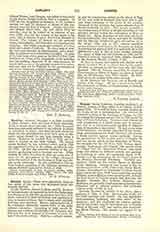

Donner, GEORG RAPHAEL, Austrian sculptor, b. at Essling, Austria, May 25, 1692; d. at Vienna, February 15, 1741. It is said his fancy was first kindled by the works of art at Heiligenkreuz. He received his technical training in the Academy at Vienna; in 1724 he entered the imperial service, and in 1729 passed to that of Prince Esterhazy. Donner’s work stands out with prominence in a period given over to mannerism, but he is sometimes more mindful of elegance than of character in his subject. He had a true sense of the beautiful, was lifelike and noble in his conceptions, and represents for South Germany and Austria a classic reaction against rococo methods. Among his productions are the marble statue of Charles VI and two bronze reliefs in the Belvedere at Vienna, the fountain for the old Town Hall, Vienna, representing “Andromeda and Perseus”, the marble reliefs of “Hagar” and the “Samaritan Woman“, and many busts and statues in different palaces and gardens. In Pressburg he made the equestrian statue of St. Martin, and the decorations for the burial chapel of the Primate Emmerich Esterhazy. Youthful productions (1726) are the marble figures at Mirabell Castle, Salzburg. Donner is best known today by his famous fountain (1738-1739) of the Neuen Markt, Vienna; “Providence” or “Foresight”, a classic female figure, forms the apex, while lower down four sporting children, each holding a water-spouting fish, embody the four rivers of Austria proper that flow into the Danube. Donner’s two brothers, Sebastian and Matthaus, are generally numbered among his seholars. Sebastian was a talented sculptor, and produced various works, mostly in lead.
DONNER, MATTHAUS, brother of the above, also a sculptor, b. 1704; d. 1756. He is known chiefly for his relief carvings and medals. He was appointed court-medallist, professor, and later rector of the Academy, and was employed by various princes. Among his medals may be mentioned one of Charles Albert of Bavaria, 1727, and various ones representing Maria Theresa. His medals are signed D. or M. D.
M. L. HANDLEY

